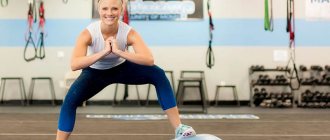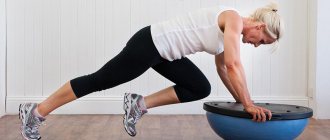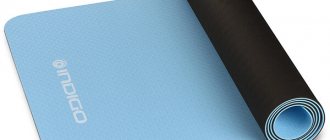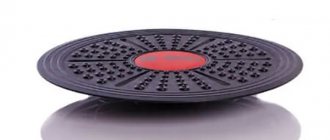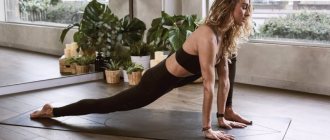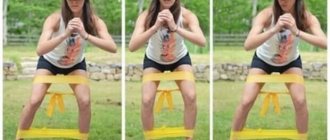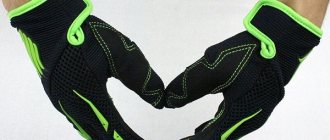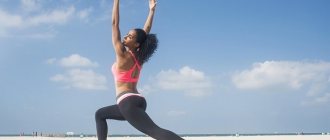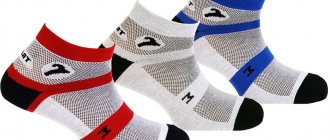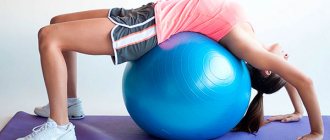Bosu is a gymnastics machine for strengthening muscle strength and developing a sense of balance (or stability). Bosu fitness can become not only something new in your activities, but an effective means of working on your body.
“The beauty of the Bosu is that you can do all kinds of exercises with it, from leg exercises to abdominal work to upper torso work with elements of cardio,” says Autumn Calabrese, Beach Body trainer and creator “80 days of effective fitness” courses. Find out the benefits of such activities with the Bosu hemisphere.
Any exercise on the hemisphere adds an element of instability, which forces additional abdominal muscles to work. This helps you gain better control of your body and improve your sense of balance.
The end result is a more intense core workout, regardless of which muscles are worked with each specific exercise. And work on your sense of balance with the help of a Bosu gymnastic ball.
Hemisphere exercises are best started with the basics and only then become more complex as your confidence grows. The first thing I recommend you do before starting any Bosu fitness is simply stand on a round surface and feel the beneficial instability that this tool provides.
With this machine, you can use either a round or flat surface, which further increases the variability of your workout. The exercises presented below on a hemisphere are shown to work on individual muscle sections. But before you start, pay attention to the need for a light warm-up to prepare your body for the load.
What is bosu training in fitness
Bosu - a compact exercise machine, is a rubber hemisphere that is attached to a round stable platform. Something between step and fitball. Similar to a step, the balancing platform has a non-slip, stable coating, and the upper part resembles a small fitball in shape and quality.
Accordingly, a new trend in fitness at that time began to quickly gain popularity. The training consisted of performing aerobic exercises with choreographic elements, connected in sequences (as in step aerobics) to rhythmic music. Later, bosu found application in other areas: functional training, strength training, Pilates and other types of fitness, where it is necessary to develop stabilizer muscles, balance, coordination, and strengthen muscles using your own weight.
About the structure, name, appearance and composition
A gymnastic hemisphere is additional sports equipment, which is presented in the form of a balancing platform and a hemisphere made of rubber with a special hole that helps regulate its height and elasticity by inflating or deflating air. Some call this type of exercise machine the abbreviation "BOSU" from the original English phrase "Both Sides Up" (translated: "Both Sides Up"), although the phrase was later changed, and today it sounds like "Both Sides Use" (translated: : "Both sides are used").
Weight: 4-7 kg.
Sphere diameter: 58-63 cm.
Height: 24-30 cm.
Material: PVC (polyvinyl chloride), that is, plastic, and rubber or silicone.
Color: most often blue and green, but gray and red colors are also found.
Includes: pump, rubber shock absorbers (expanders).
Maximum holding weight: 100-136 kg.
Advantages of practicing on the Bosu hemisphere
- Improves the tone of both external and internal muscles.
- Improves coordination, develops balance, allowing you to work stabilizer muscles.
- Using the simulator, you can work out all muscle groups without using other types of equipment.
- Exercise increases endurance, improves general condition, and also allows you to lose weight and get your body into athletic shape.
- Bosu exercises do not overload the joints and spine. The soft hemisphere relieves shock and compression of the joints when performing any exercise.
Tips for Beginners
- Exercise in shoes with flat rubber soles
– sneakers or sneakers. When you feel more confident on the hemisphere, you can perform the exercises barefoot.
- Before starting the complex, be sure to warm up.
When you lose balance, “cold” muscles are easier to injure.
- For the first training, do not try to inflate your boss as much as possible.
: The less elastic the hemisphere, the easier it will be to master a new type of fitness.
- Take care of your inventory.
Some instructors suggest adding variety to your workout by flipping the bosu. But you must understand: if you regularly stand on a flat base, the exercise machine will quickly become unusable.
- Pick up dumbbells
only when you master the hemisphere well and learn to stand on it in any position.
- Place your feet closer to each other
when standing on the dome part. Bend your knees halfway. This is the easiest way to maintain balance.
Most importantly: don't expect instant results! Bosu training is difficult and unusual for a beginner. And the fact that in the first weeks you will constantly lose your balance is quite normal. Be patient and within a month you will get used to the new simulator.
Top 13 best barefoot exercises and training scheme
Squats on a hemisphere
- Slowly place your feet hip-width apart, keeping your balance on the hemisphere (on the soft part).
- Squat your hips until they are parallel to the floor, smoothly move your pelvis back, maintaining balance. Keep your hands in front of you.
- Exhale and slowly rise up.
Perform the exercise 15-25 times.
Option 2: Inverted Bosu Squats
turn the hemisphere upside down and repeat the technique.
Perform the exercise 15-25 times.
Attention! This option is only for those who are prepared, as it requires more stabilization due to instability.
Backward Lunges
- Stand with both feet on the hemisphere.
- Take a step back with your right foot, placing your toe on the floor.
- Exhale, push off with your front supporting leg and step back, maintaining your balance.
- Change your leg.
Alternate movements on each side for 15-20 lunges.
Side Lunges
- Standing on a hemisphere, feet together.
- As you inhale, take a step with your right foot to the side, placing your foot on the floor. At the bottom point, perform a squat with your knees bent. The thigh of the supporting leg is parallel to the floor.
- Exhale – reverse step on the barefoot.
- Repeat the movement on your left leg.
Alternate 15-20 lunges on both legs.
Dynamic barefoot plank
- Place your palms on a hemisphere shoulder-width apart. Stand in a plank position, controlling the position of your lower back.
- Keeping your abdominal muscles tense, alternately lower yourself onto your forearm with each hand, and straighten your elbows back, lifting up onto your palms.
- Alternate the movement at a dynamic pace without holding your breath.
Perform the exercise for 30-60 seconds.
Push ups
- Place your palms narrowly, shoulder-width apart. Stand in a plank position; to make the technique easier, you can rest your knees on the floor.
- As you inhale, bend your elbows, bringing them closer to your torso, and aim your chest toward the top point of the bosu.
- Exhale and do push-ups.
Do 10-15 push-ups.
Inverted hemisphere push-ups
- Place the hemisphere on the floor, placing your palms along the edges of the platform.
- Slowly do push-ups as described in the technique above.
Do 10-15 push-ups.
Gluteal bridge
- Lying with your back on the mat, place your feet on the hemisphere, bending your knees.
- Place your arms along your body.
- As you exhale, lift your buttocks off the floor, rising to the “half-bridge” position without lifting your shoulder blades from the floor. The torso and hips form a straight line, without arching in the lower back.
- Inhale – slowly lower your pelvis to the floor.
Repeat the movement 15-25 times.
Glute bridge: single leg pelvic lift
- Place one foot on the center of the hemisphere, and keep the other straight in weight;
- push your pelvis out 15 times, then switch legs.
You can also turn the sphere upside down.
Burpee with Bosu
The burpee variation is suitable for beginners.
- Stand facing the hemisphere, perform a squat and place your palms under your shoulders on your bare feet.
- As you inhale, jump into a plank position, keeping your spine straight.
- As you exhale, jump back to the bosu platform and return to a vertical position with another jump.
Repeat the cycle 10-15 times.
Hyperextension on barefoot
- Lie on your stomach on the hemisphere. Keep your knees straight, resting on your toes.
- Place your hands behind your head, keeping your spine straight and your chest hanging over the floor.
- Inhale – tilt your body down towards the floor, lengthening your spine.
- Exhale and straighten your torso without arching your lower back. Keep your abdominal muscles tense and perform the exercise with a small amplitude.
Do 15-25 reps.
Fold
- Sit with your buttocks on the hemisphere, maintaining balance and tension in your abdominal muscles, lift your heels off the floor, bend your knees, and lean your body slightly back.
- Opening up like a book, straighten your legs at the knees, lowering them lower to the floor, and also move your body back, without bringing the body line to the horizontal. Keep your hands in front of you, and keep your abs in constant tension.
- Exhale as you fold, returning your bent knees to your torso.
- To make this option easier, you can hold the exercise machine with your palms.
Perform 20-30 crunches.
Oblique twists on a hemisphere
The exercise is performed like a regular bicycle.
- Sitting barefoot, hold your hands behind your head, your legs overhang, bending them at the knees.
- As you exhale, twist diagonally, aiming your right elbow towards the opposite knee.
- Inhale: Return to the starting point and twist in the opposite direction.
- Perform crunches dynamically without relaxing your abs.
Perform 20-30 repetitions.
The set of exercises is designed to work all muscle groups evenly. Perform the program in a circle, moving from exercise to exercise without pauses, at the end of the cycle, rest for 2-3 minutes, repeat 3 circles.
Recommendations for using the projectile
Before starting regular exercises with this simulator, it is important to adhere to a number of general rules for working with it:
- Shoes must be equipped with a strictly non-slip platform.
- The feet should be placed parallel to the center, and the knees should be left bent.
- It is not recommended to pick up weights until full balance is established on the rubber part of the platform.
- The body must be kept straight, and the abs and buttocks must be tense.
Top manufacturers of Bosu exercise machines
- BOSU is an American brand that appeared in 2000, patented and was the first to begin producing hemispheres. The brand is very popular in the world, and in Russia their products can be found in more than a thousand fitness clubs. Starting cost from 16,500 rubles.
- IFITFUN - a Taiwanese brand that strives for the quality of Bosu originals, produces hemispheres with anti-slip platforms, making training safer. The brand has also added expanders to its products to work all the muscles of the body. The cost of goods varies from 7,500 to 14,000 rubles.
- Tunturi, a budget Chinese brand registered in the Netherlands, produces exercise equipment for home use, for example, Balance Trainer (14TUSFU152). The hemisphere is designed with two handles to improve the load. The company also took care of novice users by including a diagram with exercises in the set. Approximate cost is about 7,000 rubles.
Reviews
Stanislav5
The thing looks simple, but is multifunctional (it will help improve (restore) posture, correct figure imperfections and increase endurance). This miracle thing is good for aerobics. The exercises are the same if you have ever attended group fitness classes. Another advantage of the Bosu is that it can be turned over and used on a flat surface. Of course, maintaining a balance like this is even more difficult, but it is also useful. Personally, I started training twice a week. Sometimes there are three, but rarely. Barefoot exercises, although gentle in terms of assistance and stress on your joints and muscles, are energy-consuming in terms of calorie loss. If you love winter sports, then Bosu will help you remember your skills and, in addition, help you strengthen your endurance. And all this while maintaining balance. After all, balance is very important in figure skating, skiing and snowboarding, which is very fashionable today.
IrinaFedash
The Bosu platform is a hemisphere (very similar to a fitness ball, only it has a mat and a plastic base at the bottom). The hemisphere itself can be pumped more or less, depending on the level of training and the desired result; for the best result, it needs to be pumped up well, so that doing the exercise is difficult, because on Bosu, in order to maintain balance, you need to put in a lot of effort. You can also use the simulator in several variations: with the “ball” up or with the plastic base up! Probably many will ask what exercises can be done on it? - all the same ones that you perform in regular fitness or aerobics, only performing ordinary steps or jumps will be much more difficult than on the floor, and so will the rest of the exercises! This platform further develops endurance and coordination of movements, but I don’t consider it an integral fitness tool, but it will definitely help you complicate your workout and make it fun!
Stretching
Stretching and yoga are necessary for every person. Just “pumping up muscles” is not enough. The body should be flexible and elastic . After strength training, it is imperative to restore and relax your muscles. Stretching exercises are great for this. You can do a full gymnastics workout, or you can do a few stretching exercises at the end of your cardio or strength training.
